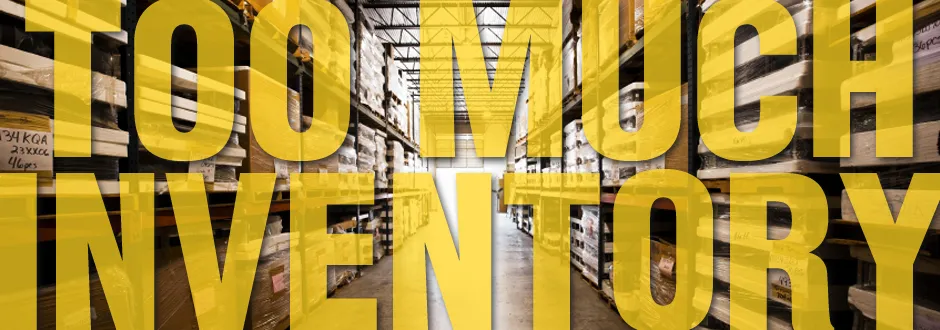
In your zeal to avoid stockouts, you might tie up too much money in overstocked items. This often indicates a problem with knowing your up-to-date
inventory levels and perhaps a breakdown in the purchasing department. Whatever the cause, it’s costing you money that could spend elsewhere, and it’s raising your storage costs -- and thus your cost of goods sold -- leaving you with the feeling your business is out of control.
For a merchandiser, inventory can represent the largest current asset. You want to use it productively. One measure is turnover -- the number of times you sell your entire inventory investment in the course of one year. Figures in the two-to-four range are customary, depending on your retail segment. In other words, you are carrying from three to six months of inventory in your warehouse or stockroom. You may have so much money tied up in slow-moving inventory that you can’t afford to restock other inventory items. Customers will have little sympathy for this state of affairs. Here are a few ways you can add a little discipline to your inventory planning.
How Intense is Your SKU?
How many stock keeping units do you keep on hand per inventory item? You should keep enough on hand to last a month if you do monthly purchasing. Of course, buying more frequently lets you lower your SKU intensity, but there is a tradeoff. In this case, the increased costs of ordering, billing and receiving. Gauging your projected sales of a specific item might be easy, but what if you sell an item with multiple sizes – like clothing. You’ll need to order a variety of sizes and colors to meet customer demand. This multiplies your SKU intensity.
You may have a good idea of how many size 14’s you sell compared to size two’s, and can order appropriately. The information is there in your
inventory systems history file – If you have an inventory system. Thus armed, you can order based on level of allowable stockouts. For example, you might be happy to have 95 percent of all requested stock on hand; especially if you can avoid a lot of extra inventory by forgoing the remaining 5 percent of sales.
You need to understand what your system is telling you. Maybe you’re not selling any size two dresses because you don’t ever stock size two dresses. That’s very different from a lack of demand. Tailoring your SKU intensity means pulling together sales and inventory information to figure out what’s going on with your inventory. One caveat: historical information can mislead. If your records tell you green dresses sell the best, you might be unprepared for a red trend or a shipment of dresses featuring a putrid shade of green. Use your knowledge and experience to interpret your historical data.
Cycle Times for Re-Ordering
How quickly can you get replacement merchandise once you run low? The longer it takes the more items you must keep on hand and the higher your costs.
Perpetual inventory systems will track sales and inventory movements in real time; allowing for the automatic reordering of merchandise when it’s economically optimal. However, the system must know your sales rates and shipment times to be efficient. Properly set up, the computer can place orders every day, as needed.
If you have a perpetual inventory system and don’t track inventory or sales in real time, your ordering cycle is probably delayed because you don’t place orders every day. If you order once a week, add seven days to your cycle time. Of course, unless you take a count every week in your periodic system, you’re liable to over-order to maintain some safety stock against the possibility of running out. This increases you turnover time and your costs.
Other Factors
You will order items that expire more frequently (like food) than woman’s dresses; the nature of the merchandise is an important factor. Customers will buy mouthwash without too much deliberation but may come back three times before deciding on which floor tiles to buy. You have no choice but to expect lower turnover rates for deliberation merchandise. However, the customer will probably understand your need to order and that you may not keep more than a sample amount on hand.
Another factor is the gross margin return on inventory investment. This financial measure tells you the dollar return for each dollar spent on inventory. It’s an important measure because it can tell you that highly profitable but slow moving inventory is worth less than quickly moving items with a smaller markup. Figure gross margin return as profit divided by the average inventory at cost. Tailor your inventory purchases toward items with a high gross margin return. Take into account the actual amount of money returned -- you have to earn enough to pay your bills.
Summing Up
Don’t overbuy. Use the information on hand and a little math to figure out where to spend your inventory dollars.
Track inventory movements and sales in real time and automatically re-order stock. Mark down slow moving inventory but only after figuring out why the items are slow sellers. Try to get exclusive rights to certain products, such as dresses from a particular maker, because your customers may allow you to backorder. Encourage sales with loyalty programs and gift registries. Keep your marked down items in the back of the store where customers must first pass full-priced merchandise. Over time, careful planning will reduce your inventory overages and costs.
 In your zeal to avoid stockouts, you might tie up too much money in overstocked items. This often indicates a problem with knowing your up-to-date
In your zeal to avoid stockouts, you might tie up too much money in overstocked items. This often indicates a problem with knowing your up-to-date